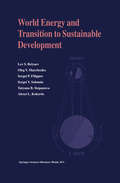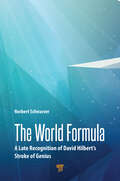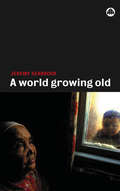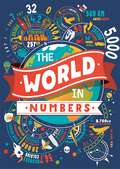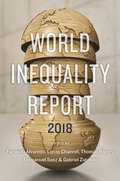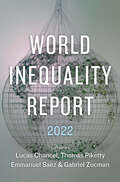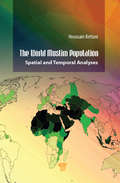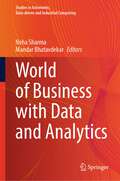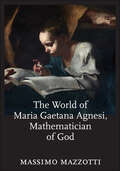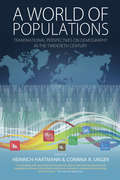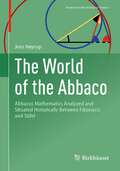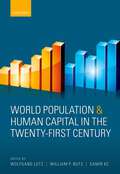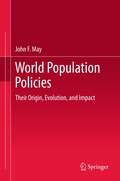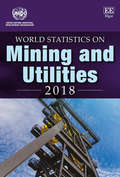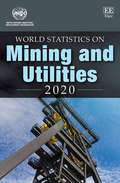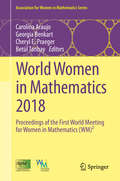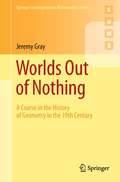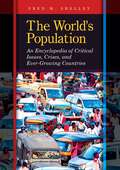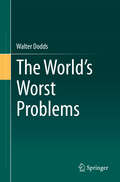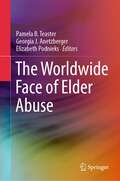- Table View
- List View
World Energy and Transition to Sustainable Development
by Lev S. Belyaev Oleg V. Marchenko Sergei P. Filippov Sergei V. Solomin Tatyana B. Stepanova Alexei L. KokorinThis book presents the results of a study of long-term perspectives for energy development of the world and its main regions, performed at the Siberian Energy Institute of the Russian Academy of Sciences (Energy Systems Institute since 1998). The methodological approach, the 10-regional Global Energy Model (GEM-10R) of the world energy system, energy demand forecasts, data on energy resources and energy technologies, and results of calculations based on mathematical models are described. Particular attention is given to determination of energy requirements and peculiarities of its technological structure that are caused by mankind's necessary transition to sustainable development. Economic and ecological consequences of constraints on greenhouse gas emissions and scales of nuclear energy production, as well as assistance of developed countries to developing ones are investigated. Problems of cheap oil, gas and uranium resources depletion, fuel price growth, synthetic fuel production and new energy technology implementation are analysed. The book is intended for specialists in energy and economics, as well as students and postgraduate students of technical high schools and universities. ac
The World Formula: A Late Recognition of David Hilbert‘s Stroke of Genius
by Norbert SchwarzerSurely the reader had come across situations where he would have given his life to get the “final answer”, the reason for our existence, a Theory of Everything, a true World Formula that contains it all… So did the author of this book. There was this deep-seated and forever unquenchable thirst for fundamental explanations on the one hand, and then there was this very special motivation from somebody else who needed this knowledge, on the other: “How to explain the world to my dying child?” Perhaps this provided the driving force to actually start this million-mile-long journey with the first small—and very tentative—step. Considering all the efforts taken, money spent, disputes fought, papers and books written, and conferences held, it is almost shocking to find that, in principle, the World Formula was already there. It was David Hilbert who wrote it down during World War I in November 1915. The complexity of the math involved was not the only thing that obscured what should have been obvious. This book explains why apparently only very few people had realized his immortal stroke of genius.
The World Formula: A Late Recognition of David Hilbert‘s Stroke of Genius
by Norbert SchwarzerSurely the reader had come across situations where he would have given his life to get the “final answer”, the reason for our existence, a Theory of Everything, a true World Formula that contains it all… So did the author of this book. There was this deep-seated and forever unquenchable thirst for fundamental explanations on the one hand, and then there was this very special motivation from somebody else who needed this knowledge, on the other: “How to explain the world to my dying child?” Perhaps this provided the driving force to actually start this million-mile-long journey with the first small—and very tentative—step. Considering all the efforts taken, money spent, disputes fought, papers and books written, and conferences held, it is almost shocking to find that, in principle, the World Formula was already there. It was David Hilbert who wrote it down during World War I in November 1915. The complexity of the math involved was not the only thing that obscured what should have been obvious. This book explains why apparently only very few people had realized his immortal stroke of genius.
A World Growing Old
by Jeremy SeabrookFor the first time in history, the world's population is ageing. For rich countries in the west, economies rely on youthful populations to provide for those who have retired. We face a profound economic and social crisis - how do we care for the elderly when pensions and social security systems are under threat, housing is short and fewer young people are entering the workplace? *BR**BR*Yet this is only half the story. Populations in the poorer countries of the South are also ageing. Life-expectancy has increased due the availability of lifesaving medicine. Child mortality has decreased, so people are having smaller families. India will soon have one of the largest populations of over-sixties. The one-child policy in China will similarly lead to a severe imbalance in the age-profile of the people. *BR**BR*In A World Grown Old, Jeremy Seabrook examines the real implications of the ageing phenomenon and challenges our preconceptions about how it should be tackled. Arguing that the accumulated skills of the elderly should be employed to enrich society, rather than being perceived as a 'burden', he calls for a radical rethinking of our attitude to population issues, migration, social structures and employment policy.
The World in Numbers
by Clive Gifford Marianne Taylor Steve MartinA quirky, full-colour illustrated book jam-packed with over 2,000 fascinating figures and facts, The World in Numbers lets figures do the talking.Each themed, colourful page is crammed with tonnes of fascinating number-led facts. Discover how fast a sneeze travels, how many Earths could fit inside the Sun, the size of a T-rex’s teeth and much, much more. From animals and adventures, to fashion, food, bugs and buildings — there’s something for everyone in this brilliant book. Featuring light-hearted illustrations by Andrew Pinder.
The World Inequality Report: 2018
by Facundo AlvaredoThe World Inequality Report: 2018 is the most authoritative and up-to-date account of global trends in inequality. Researched, compiled, and written by a team of the world’s leading economists of inequality, it presents—with unrivaled clarity and depth—information and analysis that will be vital to policy makers and scholars everywhere. Inequality has taken center stage in public debate as the wealthiest people in most parts of the world have seen their share of the economy soar relative to that of others, many of whom, especially in the West, have experienced stagnation. The resulting political and social pressures have posed harsh new challenges for governments and created a pressing demand for reliable data. The World Inequality Lab at the Paris School of Economics and the University of California, Berkeley, has answered this call by coordinating research into the latest trends in the accumulation and distribution of income and wealth on every continent. This inaugural report analyzes the Lab’s findings, which include data from major countries where information has traditionally been difficult to acquire, such as China, India, and Brazil. Among nations, inequality has been decreasing as traditionally poor countries’ economies have caught up with the West. The report shows, however, that inequality has been steadily deepening within almost every nation, though national trajectories vary, suggesting the importance of institutional and policy frameworks in shaping inequality. The World Inequality Report: 2018 will be a key document for anyone concerned about one of the most imperative and contentious subjects in contemporary politics and economics.
World Inequality Report 2022
by Lucas Chancel, Thomas Piketty, Emmanuel Saez and Gabriel ZucmanProduced by a team of world-leading economists, this is the benchmark account of recent and historical trends in inequality.World Inequality Report 2022 is the most authoritative and comprehensive account available of global trends in inequality. Researched, compiled, and written by a team of world-leading economists, the report builds on the pioneering edition of 2018 to provide policy makers and scholars everywhere up-to-date information about an ever broader range of countries and about forms of inequality that researchers have previously ignored or found hard to trace.Over the past decade, inequality has taken center stage in public debate as the wealthiest people in most parts of the world have seen their share of the economy soar relative to that of others. The resulting political and social pressures have posed harsh new challenges for governments and created a pressing demand for reliable data. The World Inequality Lab, housed at the Paris School of Economics and the University of California, Berkeley, has answered this call by coordinating research into the latest trends in the accumulation and distribution of income and wealth on every continent. This new report not only extends the lab’s international reach but provides crucial new information about the history of inequality, gender inequality, environmental inequalities, and trends in international tax reform and redistribution.World Inequality Report 2022 will be a key document for anyone concerned about one of the most imperative and contentious subjects in contemporary politics and economics.
The World Muslim Population: Spatial and Temporal Analyses
by Houssain KettaniThe birth of Islam over fourteen centuries ago was a monumental event in human history with an everlasting effect on humanity. For centuries, researchers have contemplated on the growth and distribution of Muslims throughout the world. This book presents a reliable estimate of the world Muslim population since the inception of Islam at the start of the seventh century to the end of the twenty-first century. In this book, the world is divided into five continents, each of which is further divided into non-overlapping regions, and these in turn are divided into current countries. A centennial data estimate for each region and current country from 600 AD to 2100 AD (approximately 1 H to 1500 H) of the total population, and the corresponding Muslim population and its percentage are provided. Furthermore, the same data in decennial order from 1790 to 2100 (or 1210 H to 1520 H) is provided for each region and country. These data are summarized to be a reference for other studies and discussions related to the Muslim population.
The World Muslim Population: Spatial and Temporal Analyses
by Houssain KettaniThe birth of Islam over fourteen centuries ago was a monumental event in human history with an everlasting effect on humanity. For centuries, researchers have contemplated the growth and distribution of Muslims throughout the world. This book presents a reliable estimate of the world Muslim population since the inception of Islam at the start of the seventh century to the end of the twenty-first century. In this book, the world is divided into five continents, each of which is further divided into non-overlapping regions, and these in turn are divided into current countries. A centennial data estimate for each region and current country from 600 AD to 2100 AD (approximately 1 H to 1500 H) of the total population, and the corresponding Muslim population and its percentage are provided. Furthermore, the same data in decennial order from 1790 to 2100 (or 1210 H to 1520 H) are provided for each region and country. These data are summarized to be an accurate reference for other studies and discussions related to the Muslim population. Written for demographers, researchers, historians, as well as general readers, this book is an essential reference to all aspects of the world Muslim population.
World of Business with Data and Analytics (Studies in Autonomic, Data-driven and Industrial Computing)
by Neha Sharma Mandar BhatavdekarThis book covers research work spanning the breadth of ventures, a variety of challenges and the finest of techniques used to address data and analytics, by subject matter experts from the business world. The content of this book highlights the real-life business problems that are relevant to any industry and technology environment. This book helps us become a contributor to and accelerator of artificial intelligence, data science and analytics, deploy a structured life-cycle approach to data related issues, apply appropriate analytical tools & techniques to analyze data and deliver solutions with a difference. It also brings out the story-telling element in a compelling fashion using data and analytics. This prepares the readers to drive quantitative and qualitative outcomes and apply this mindset to various business actions in different domains such as energy, manufacturing, health care, BFSI, security, etc.
The World of Maria Gaetana Agnesi, Mathematician of God (Johns Hopkins Studies in the History of Mathematics #2)
by Massimo MazzottiShe is best known for her curve, the witch of Agnesi, which appears in almost all high school and undergraduate math books. She was a child prodigy who frequented the salon circuit, discussing mathematics, philosophy, history, and music in multiple languages. She wrote one of the first vernacular textbooks on calculus and was appointed chair of mathematics at the university in Bologna. In later years, however, she became a prominent figure within the Catholic Enlightenment, gave up academics, and devoted herself to the poor, the sick, the hungry, and the homeless. Indeed, the life of Maria Agnesi reveals a complex and enigmatic figure—one of the most fascinating characters in the history of mathematics. Using newly discovered archival documents, Massimo Mazzotti reconstructs the wide spectrum of Agnesi's social experience and examines her relationships to various traditions—religious, political, social, and mathematical. This meticulous study shows how she and her fellow Enlightenment Catholics modified tradition in an effort to reconcile aspects of modern philosophy and science with traditional morality and theology.Mazzotti's original and provocative investigation is also the first targeted study of the Catholic Enlightenment and its influence on modern science. He argues that Agnesi's life is the perfect lens through which we can gain a greater understanding of mid-eighteenth-century cultural trends in continental Europe.
A World of Populations: Transnational Perspectives on Demography in the Twentieth Century
by Heinrich Hartmann Corinna R. UngerDemographic study and the idea of a “population” was developed and modified over the course of the twentieth century, mirroring the political, social, and cultural situations and aspirations of different societies. This growing field adapted itself to specific policy concerns and was therefore never apolitical, despite the protestations of practitioners that demography was “natural.” Demographics were transformed into public policies that shaped family planning, population growth, medical practice, and environmental conservation. While covering a variety of regions and time periods, the essays in this book share an interest in the transnational dynamics of emerging demographic discourses and practices. Together, they present a global picture of the history of demographic knowledge.
The World of the Abbaco: Abbacus Mathematics Analyzed and Situated Historically Between Fibonacci and Stifel (Frontiers in the History of Science)
by Jens HøyrupThe abbacus was a thorough and complete system of arithmetical calculations, which saw its dawn in the Indian and Arabic tradition of the Middle Ages, but which was developed in its fully fledged aspects especially in Italy, between Genoa, Milan, Venice and the region of Umbria. In this monograph, Høyrup explores how the abbacus tradition has developed in Europe, with a focus on Italy and Germany between the 14th and the 17th Century. With the analysis of texts from Fibonacci, Pacioli, and Stifel to name but a few, this book offers a critical historical analysis of the development and diffusion of a tradition of calculus that has deeply influenced the way in which mathematics has developed in the West. The primary purpose of the book is to present a fairly detailed portrait of the abbacus tradition as it developed historically; as will be argued, Fibonacci was much less important for the emergence of this tradition than mostly assumed – but since his importance isbroadly taken for granted, that argument needs to be made, for which reason Fibonacci’s Liber Abbaci is also described and analyzed in some depth. A secondary purpose is to show how the adoption of abbacus mathematics in German lands gave rise to the creation of a different tradition. The end of the book investigates the interplay of abbacus algebra with other intellectual currents which turned the whole mathematical undertaking upside-down in the 17th Century.
World Population and Human Capital in the Twenty-First Century
This book addresses systematically and quantitatively the role of educational attainment in global population trends and models. Six background chapters summarize past trends in fertility, mortality, migration, and education; examine relevant theories and identify key determining factors; and set the assumptions that are subsequently translated into alternative scenario projections to 2100. These assumptions derive from a global survey of hundreds of experts and five expert meetings on as many continents. Another chapter details their translation into multi-dimensional projections by age, sex, and level of education. The book's final chapters analyse the results, emphasizing alternative trends in human capital, new ways of studying ageing and the quantification of alternative population, and education pathways in the context of global sustainable development. An appendix and associated web link present detailed results for all countries. The book shows that adding education to age and sex substantially alters the way we see the future.
World Population Policies: Their Origin, Evolution, and Impact
by John F. MayThis book examines the history behind the formulation, implementation, and evaluation of population policies in the more developed, the less developed, and the least developed countries from 1950 until today, as well as their future prospects. It links population policies with the theories of the demographic, epidemiological, and migratory transitions. It begins by summarizing the demographic situation around the world, with an emphasis on population policies and their underlying theories. Then, it reviews the early efforts to reduce mortality and fertility in the developing countries. This is followed by a description of the internationalization of the debate on population issues and the transformation of these programs into more formal population policies, particularly in the developing countries. The book reviews also the situation of the developed countries and their specific challenges – sub-replacement fertility, population aging, and immigration – and examines the effectiveness of population policies. It also explores the way forward and future prospects for population policies over the next decades. The book provides numerous concrete examples from all over the world, and show how population policies are actually implemented and what have been their successes as well as their constraints. Above all, the book highlights the importance of understanding underlying demographic trends when assessing the development prospects of any country.The book is recommended for not only demographers, social scientists, and policymakers but also economists and political scientists who are interested in social and demographic change around the world. Demography students and researchers who are interested in applying knowledge on population trends and prospects in designing and evaluating public policies will find this an invaluable reference work.
World Statistics on Mining and Utilities 2018
by UnidoWorld Statistics on Mining and Utilities 2018 provides a unique biennial overview of the role of mining and utility activities in the world economy. This extensive resource from UNIDO provides detailed time series data on the level, structure and growth of international mining and utility activities by country and sector. Country level data is clearly presented on the number of establishments, employment and output of activities such as coal, iron ore and crude petroleum mining as well as the production and supply of electricity, natural gas and water. This unique and comprehensive source of information meets the growing demand of data users who require detailed and reliable statistical information on the primary industry and energy producing sectors. The publication provides internationally comparable data for economic researchers, development strategists and business communities who influence the policy of industrial development and its environmental sustainability.
World Statistics on Mining and Utilities 2020
by UNIDOWorld Statistics on Mining and Utilities 2020 provides a unique biennial overview of the role of mining and utility activities in the world economy. This extensive resource from UNIDO provides detailed time series data on the level, structure and growth of international mining and utility activities by country and sector. Country level data is clearly presented on the number of establishments, employment and output of activities such as coal, iron ore and crude petroleum mining as well as the production and supply of electricity, natural gas and water. This unique and comprehensive source of information meets the growing demand of data users who require detailed and reliable statistical information on the primary industry and energy producing sectors. The publication provides internationally comparable data for economic researchers, development strategists and business communities who influence the policy of industrial development and its environmental sustainability.
The World through the Lens of Mathematics
by Natali Hritonenko Yuri YatsenkoHundreds of meticulously crafted mathematical problems and puzzles in this book are incorporated into fascinating stories about our world. These wor(l)d problems are grouped by their mathematical concepts such that the titles of sections and chapters combine both mathematical and applied terms, hinting at the topics covered. Detailed solutions conclude each section. Following in the success of the authors’ previous book, USA Through the Lens of Mathematics, this text contributes to the novel pedagogical call for a more multidisciplinary approach in education. The various types of questions posed in The World through the Lens of Mathematics are stimulating, entertaining, and educational. Their main objective is to provide a thorough review of the fundamental concepts of algebra and geometry, reduce mathematical anxiety, and emphasize the applicability and versatility of mathematics. Working these problems shatters the barriers between the students and mathematics by encouraging them to look at the subject from a different perspective. Students are simultaneously enriched with new knowledge of historical events, customs, and geography of countries around the world, each one of which is mentioned throughout the pages of this book.
The World through the Lens of Mathematics
by Natali Hritonenko Yuri YatsenkoHundreds of meticulously crafted mathematical problems and puzzles in this book are incorporated into fascinating stories about our world. These wor(l)d problems are grouped by their mathematical concepts such that the titles of sections and chapters combine both mathematical and applied terms, hinting at the topics covered. Detailed solutions conclude each section. Following in the success of the authors’ previous book, USA Through the Lens of Mathematics, this text contributes to the novel pedagogical call for a more multidisciplinary approach in education. The various types of questions posed in The World through the Lens of Mathematics are stimulating, entertaining, and educational. Their main objective is to provide a thorough review of the fundamental concepts of algebra and geometry, reduce mathematical anxiety, and emphasize the applicability and versatility of mathematics. Working these problems shatters the barriers between the students and mathematics by encouraging them to look at the subject from a different perspective. Students are simultaneously enriched with new knowledge of historical events, customs, and geography of countries around the world, each one of which is mentioned throughout the pages of this book.
World Women in Mathematics 2018: Proceedings of the First World Meeting for Women in Mathematics (WM)² (Association for Women in Mathematics Series #20)
by Carolina Araujo Georgia Benkart Cheryl E. Praeger Betül TanbayThe first World Meeting for Women in Mathematics - (WM)² - was a satellite event of the International Congress of Mathematicians (ICM) 2018 in Rio de Janeiro. With a focus on Latin America, the first (WM)² brought together mathematicians from all over the world to celebrate women mathematicians, and also to reflect on gender issues in mathematics, challenges, initiatives, and perspectives for the future. Its activities were complemented by a panel discussion organized by the Committee for Women in Mathematics (CWM) of the International Mathematical Union (IMU) inside the ICM 2018 entitled "The gender gap in mathematical and natural sciences from a historical perspective”.This historical proceedings book, organized by CWM in coordination with the Association for Women in Mathematics, records the first (WM)² and the CWM panel discussion at ICM 2018. The first part of the volume includes a report of activities with pictures of the first (WM)² and a tribute to Maryam Mirzakhani, the first woman to be awarded the Fields medal. It also comprises survey research papers from invited lecturers, which provide panoramic views of different fields in pure and applied mathematics. The second part of the book contains articles from the panelists of the CWM panel discussion, which consider the historical context of the gender gap in mathematics. It includes an analysis of women lecturers in the ICM since its inception. This book is dedicated to the memory of Maryam Mirzakhani.
Worlds Out of Nothing: A Course in the History of Geometry in the 19th Century (Springer Undergraduate Mathematics Series)
by Jeremy GrayBased on the latest historical research, Worlds Out of Nothing is the first book to provide a course on the history of geometry in the 19th century. Topics covered in the first part of the book are projective geometry, especially the concept of duality, and non-Euclidean geometry. The book then moves on to the study of the singular points of algebraic curves (Plücker’s equations) and their role in resolving a paradox in the theory of duality; to Riemann’s work on differential geometry; and to Beltrami’s role in successfully establishing non-Euclidean geometry as a rigorous mathematical subject. The final part of the book considers how projective geometry rose to prominence, and looks at Poincaré’s ideas about non-Euclidean geometry and their physical and philosophical significance. Three chapters are devoted to writing and assessing work in the history of mathematics, with examples of sample questions in the subject, advice on how to write essays, and comments on what instructors should be looking for.
The World's Population: An Encyclopedia of Critical Issues, Crises, and Ever-Growing Countries
by Fred M. ShelleyThis one-volume encyclopedia examines key topics, major world players, and imminent problems pertaining to the world's ever-growing population.According to the United Nations, the population of our planet reached 7 billion people in 2011. What areas of the world have the most people? What measures, if any, are in place to control the population? Why is Europe's population shrinking, while the rest of the world is growing? This eye-opening encyclopedia answers questions like these by examining significant issues and topics relating to the population and exploring profiles of the most populated countries and cities of the world. More than 100 alphabetically arranged entries focus on such topics as census, demography, megacity, overpopulation, and urban sprawl. Author Fred M. Shelley, an accomplished academic in the field of environmental sustainability, reveals the steps taken by major cities such as Rio de Janeiro, Paris, Tokyo, Beijing, Mexico City, Seoul, Manila, and New Delhi in handling their population, and what is being done in China and other countries to prevent overcrowding. The text includes a discussion of how factors like migration patterns, war, and disease impact population change. This comprehensive encyclopedia also includes primary document excerpts from court cases, legislation, and political speeches relating to population issues.
The World's Population: An Encyclopedia of Critical Issues, Crises, and Ever-Growing Countries
by Fred M. ShelleyThis one-volume encyclopedia examines key topics, major world players, and imminent problems pertaining to the world's ever-growing population.According to the United Nations, the population of our planet reached 7 billion people in 2011. What areas of the world have the most people? What measures, if any, are in place to control the population? Why is Europe's population shrinking, while the rest of the world is growing? This eye-opening encyclopedia answers questions like these by examining significant issues and topics relating to the population and exploring profiles of the most populated countries and cities of the world. More than 100 alphabetically arranged entries focus on such topics as census, demography, megacity, overpopulation, and urban sprawl. Author Fred M. Shelley, an accomplished academic in the field of environmental sustainability, reveals the steps taken by major cities such as Rio de Janeiro, Paris, Tokyo, Beijing, Mexico City, Seoul, Manila, and New Delhi in handling their population, and what is being done in China and other countries to prevent overcrowding. The text includes a discussion of how factors like migration patterns, war, and disease impact population change. This comprehensive encyclopedia also includes primary document excerpts from court cases, legislation, and political speeches relating to population issues.
The World's Worst Problems
by Walter DoddsThis book addresses the worst problems currently facing humanity and those that may pose future threats. The problems are explained and approached through a scientific lens, and categorized based on data involving global mortality, vulnerability, and threat level. The book presents indices of problem severity to compare relative intensity of current and potential crises. The approach avoids emotional argument using mainly empirical evidence to support the classification of relative problem severity. The author discusses multiple global problems and ranks them. He also explores specific solutions to each problem, links problems to human behavior from a social science perspective, considers international cooperation, and finally pathways to solutions.The book discusses confirmation bias and why this necessitates a scientific approach to tackle problems. The moral assumption that each person has the same rights to life and minimal suffering, and that the natural world has a right to exist, forms the basis of ranking problems based on death, suffering, and harm to the natural world. A focus is given to potential disasters such as asteroid collisions and super-volcanic eruptions, which are then presented in chapters that address specific contemporary global issues including disease, hunger, nuclear weapons and climate change. Furthermore the author then ranks the problems based on an index of problem severity, considering what other people think the worst problems are. The relative economic costs to solve each of these problems, individual behavior in the face of these problems, how people could work together internationally to combat them, and a general pathway toward solutions form the basis of the final chapters. This work will appeal to a wide range of readers, students considering how they can help the world, and scientists and policy makers interested in global problem solving.
The Worldwide Face of Elder Abuse
by Pamela B. Teaster Georgia J. Anetzberger Elizabeth PodnieksThis book provides a picture of the abuse of older adults, organized by World Health Region and locating the problem within an area’s historic and present societal treatment of older persons. An actual and emblematic case study of the abuse of an older adult frames each chapter. Using the case study as a touchstone, each chapter guides the reader’s understanding of elder abuse in the region or country through the use of empirical data and research on the problem, explaining its usefulness and limitations as well as guiding frameworks utilized to address the problem. The book highlights the efforts of leading figures in each area or region who are addressing the problem, explaining existing policies and future initiatives to address the abuse of older adults. By providing a holistic and person-centered picture of the issue and problem of elder abuse, based on actual experiences as well as national and international statistics and research and politics and policy, this book is an invaluable resource for students, academics, social service practitioners, health professionals, law enforcement, and policymakers around the world.
